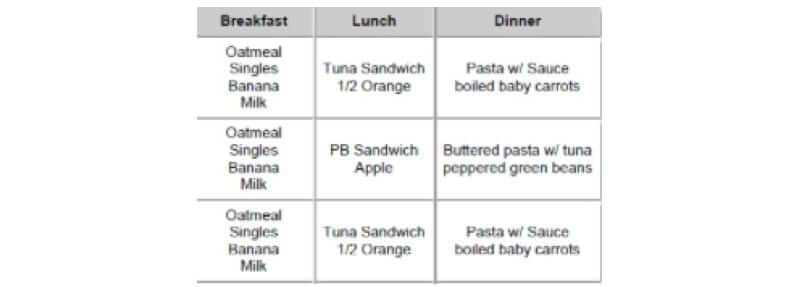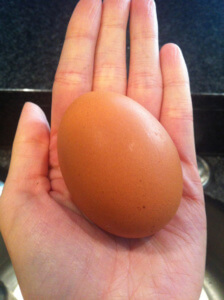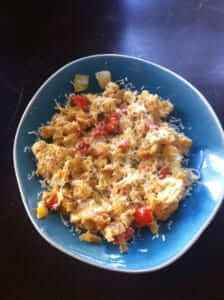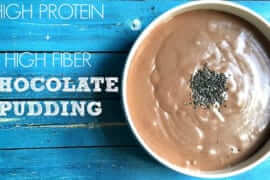This morning, before I went grocery shopping, a friend introduced me to the SNAP Challenge.
SNAP stands for Supplemental Nutrition Assistance Program, formerly the Food Stamp Program. 49% of the participants are children (aged 18 or younger). The majority of these children live in single-parent households. According to snaptohealth.org,
In total, 76% of SNAP benefits go towards households with children, 16% go to households with disabled persons, and 9% go to households with senior citizens.
The SNAP Challenge encourages people to experience what it’s like for millions of Americans living below the poverty line by spending a max of $4.80 on food per day.
I quickly considered how much I spend on food each month. Definitely a lot more than $4.80 per day. And then I remembered that I love a challenge.
After doing some more research, I quickly realized that most people were sacrificing nutrition to cut corners. Recommended meal plans were extremely nutrient deficient and grain-based, as opposed to vegetable based on healthy meat and dairy products. Here is a sample of a recommended meal plan:

This meal plan reads like a pamphlet on how to become obese and develop diabetes.
According to the CDC:
- Childhood obesity has more than doubled in children and tripled in adolescents in the past 30 years.
- The percentage of children aged 6–11 years in the United States who were obese increased from 7% in 1980 to nearly 18% in 2010. Similarly, the percentage of adolescents aged 12–19 years who were obese increased from 5% to 18% over the same period.
- In 2010, more than one-third of children and adolescents were overweight or obese.
- Obese youth are more likely to have risk factors for cardiovascular diseases, such as high cholesterol or high blood pressure. In a population-based sample of 5- to 17-year-olds, 70% of obese youth had at least one risk factor for cardiovascular disease.
- Overweight and obesity are associated with increased risk for many types of cancer, including cancer of the breast, colon, endometrium, esophagus, kidney, pancreas, gallbladder, thyroid, ovary, cervix, and prostate, as well as multiple myeloma and Hodgkin’s lymphoma.
- Children and adolescents who are obese are likely to be obese as adults and are therefore more at risk for adult health problems such as heart disease, type 2 diabetes, stroke, several types of cancer, and osteoarthritis. One study showed that children who became obese as early as age 2 were more likely to be obese as adults.
Obesity, cardiovascular disease, diabetes and several other diseases are more prevalent in low-income families.
This is undoubtedly due to a lack of resources, but we should not reinforce this with bad information.
So I am taking the Paleo SNAP Challenge. My diet for the next seven days will be extremely limited, but I will not sacrifice nutrition. Clearly, I will have to forego my daily kombucha habit, as well as my daily glass of raw kefir. I am giving up drinking my medicinal teas and all other treats I usually eat during the week.
Here is what I bought and how much I spent:

The chicken thighs are not pastured like I normally buy, but they are minimally processed and the chickens did not receive antibiotics. Both the Kerrygold cheddar and butter were on sale, the cheese is normally $3.79 and the butter $2.99. I’m very fortunate there was a sale on Kerrygold items. The ground beef is grass-fed and was purchased through my buying club, they were on sale. The tomatoes and eggs were purchased from the farmers market and are organic. The good thing about buying pastured eggs is that they’re about twice the size of regular eggs. Look at this!

I don’t generally eat breakfast but I do have a mid-morning snack. This is for two reasons: I’m not hungry in the morning. I’m a fan of intermittent fasting for nutritional purposes. The first meal, I cooked scrambled eggs with sautéed tomatoes and onions and topped with a little bit of Kerrygold cheddar. I cooked about 1/4 of this big tomato. The eggs are so large, packed full of vitamins and healthy fats. I was definitely full.

This week will be challenging.
But there is no reason the people that participate in the SNAP Program should have to sacrifice their health so that they can afford food. I hope to help educate people that it is possible to spend under $4.80 per day and still eat well by eating whole, real, unprocessed foods.
Sources:
http://site.foodshare.org/site/PageServer?pagename=programs_movement_education_snapchallenge
http://www.snaptohealth.org/snap/snap-frequently-asked-questions/
http://site.foodshare.org/site/PageServer?pagename=programs_movement_education_snapchallenge_menu





13 Comments
I think it is great that you are doing this. So many people think it is too expensive to eat a paleo diet. I always try and explain that once you cut all the junk you have a lot more of a budget for real food.
Thanks!
As a single mom of three who receives SNAP benefits, I appreciate this effort… 🙂 I’m curious though, does your buying club accept SNAP?
No they do not.
Pingback: PALEO SNAP Challenge — Prep | bittrsweet
I think it’s great that you are doing this, but if you want to increase the level of difficulty (and make it more realistic), you’d have to drive yourself to a neighborhood where the median income is within the SNAP limits. Then figure out how you’d get the foods on your list if you were limited to shopping somewhere within walking distance or a bus ride (and don’t forget to take the cost of the bus fare out of your SNAP budget). No buying clubs and unlikely to find a farmer’s market in most urban food deserts.
I suggest reading the last post of my SNAP Challenge, https://ancestral-nutrition.com/the-paleo-snap-challenge-conclusion/. I was clear that buying organic food isn’t necessary and buying inorganic is favorable to buying processed, packaged foods and carbohydrates. I spent more by buying at the farmers market and from my buying club, whereas food is MUCH cheaper is regular grocery stores.
Also, the Giant is in walking distance of my house and a good percentage of the neighborhood I live in is on SNAP. But I live in DC so there are projects next to super expensive houses, so this area is unique when it comes to that.
Dani,
I am a person who relys on SNAP. I am the epitome of the statistics: about 130 lbs overweight with chronic physical and mental health problems, and was just diagnosed with Type II Diabetes.
I live in an urbanized area that until recently has been a food desert. Now, thanks to gentrification, it’s no longer a food desert, but it’s like living in a desert next to an oasis where the fence is locked and I don’t have a key.
The stores which are most accessible to me via public transportation are chain stores and the food you described here, especially antibiotic free, grain fed, organic are 1.5 – 3 times the cost of their “traditional” counterparts.
I’m doing the research now and trying to figure out a reasonable, affordable, and effective plan to transition from being sick and overwhelmed, uneducated, and unskilled at healthy self-care, so I can budget and plan well for when I get my next allotment.
The challenge isn’t simply $4.80/a day for food. It’s $4.80/day, without independent transportion, in an affordable food desert, as a single parent experiencing deficits and limitations from physical and mental health conditions exacerbated and correlated to 40 years of only knowing how to live this life.
Thank you for publishing this. It gives me a starting point.
Blessings,
Kina
Great! Let me know if you have any questions along the way. Take care!
Going to do this for my Lenten discipline, with the $$ saved going to a local food bank. Today is day one, wish me luck. I’ve been paleo for several years, and I, too, love a challenge. Plan to eat plenty of eggs, for sure.
That’s so wonderful! Best of luck!
There is no need to forgo kefir on a limited budget. You can make your own home-made kefir for a tiny fraction of the cost of store-bought, and the quality is vastly higher. All you have to do is buy some real kefir grains – just find someone local online to sell them to you. I bought mine for $5. They will last for the rest of your life if you take care of them. Then your only cost to make your own kefir is buying the milk. As a bonus, the grains keep growing so you will soon be able to supply all your friends and family with grains of their own, or sell them and make a profit.
It is very hard to provide nutritious meals while on snap. We are a family of four who are currently depending on my income alone. With two pre-teens in the house it is difficult. I’ve been trying to lose weight and provide healthier foods for my family. I have found that it is possible to follow a paleoish diet on snap but it requires buying lots of frozen vegetables and the cheapest meats available. No grass fed beef for us. We are lucky to be in a rural area so I do keep a garden which helps with fresh vegetables. All of my snap goes toward meat, vegetables and some fresh fruit so there is no room for any of the other junk.